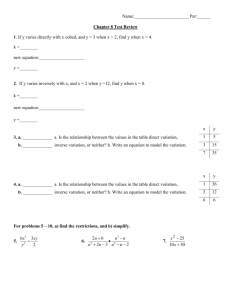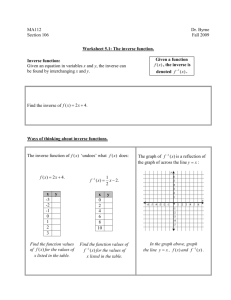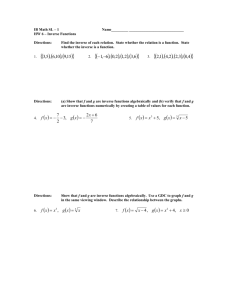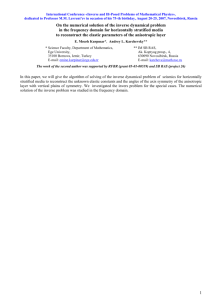Algebra and Trig. I 4.7 – Inverse Trigonometric Functions The graph
advertisement
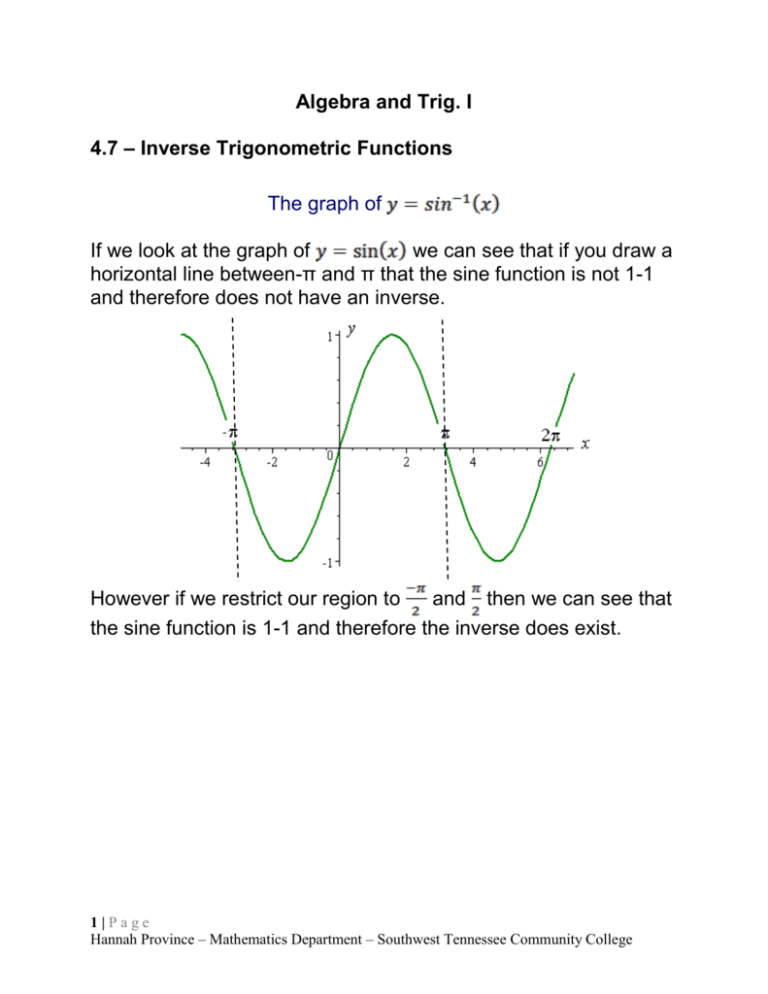
Algebra and Trig. I 4.7 – Inverse Trigonometric Functions The graph of If we look at the graph of we can see that if you draw a horizontal line between-π and π that the sine function is not 1-1 and therefore does not have an inverse. However if we restrict our region to and then we can see that the sine function is 1-1 and therefore the inverse does exist. 1|Page Hannah Province – Mathematics Department – Southwest Tennessee Community College The inverse of the restricted sine function is called the inverse sine function. The inverse sine function denoted , is the restricted sine function. . Thus: where and equals the inverse sine at x” . We read as “y The following are points on the restricted . Note if we reverse the order of the points we can see the points of x 0 y=sinx 0 0 x y= x 0 2|Page Hannah Province – Mathematics Department – Southwest Tennessee Community College Also note that the inverse of a function is the graph of the function reflected across the line y=x. Let's see the graph of y = sin x first and then derive the curve of y = arcsin x. If we reflect the indicated portion of y = sin x through the line y = x, we obtain the graph of y = arcsin x: What you see is what you get. The graph does not extend beyond the indicated boundaries of x and y. 3|Page Hannah Province – Mathematics Department – Southwest Tennessee Community College The domain (the possible x-values) of arcsin x is The range (of y-values for the graph) for arcsin x is Exact values of angle in the interval can be found by thinking of whose sine is x. as the For example: “the angle where sine is -1 is ” “the angle where sine is 1 is ” Finding exact values of 1. Let 2. Rewrite as 3. Use the exact values of sin(x) to find the value of θ in that satisfies sin(θ) Example – Find the exact value of 4|Page Hannah Province – Mathematics Department – Southwest Tennessee Community College The graph of If we restrict our region to and then we can see that the cosine function is 1-1 and therefore the inverse does exist. The inverse cosine function denoted inverse of the restricted cosine function. Thus: where and equals the inverse cosine at x” , is the . as “y . We read The following are points on the restricted . Note if we reverse the order of the points we can see the points of x 0 π y=cosx 1 -1 x y= x 1 -1 0 π 5|Page Hannah Province – Mathematics Department – Southwest Tennessee Community College Let's first recall the graph of y = cos x so we can see where the graph of y = arccos x comes from. We now choose the portion of this graph from x = 0 to x = π. The graph of the inverse of cosine x is found by reflecting the graph of cos x through the line y = x. 6|Page Hannah Province – Mathematics Department – Southwest Tennessee Community College We now reflect every point on this portion of the cos x curve through the line y = x. The result is the graph y = arccos x: That's it for the graph - it does not extend beyond what you see here. (If it did, there would be multiple values of y for each value of x and then we would no longer have a function.) The domain (the possible x-values) of arccos x is -1 ≤ x ≤ 1 The range (of y-values for the graph) for arccos x is 0 ≤ arccos x ≤ π 7|Page Hannah Province – Mathematics Department – Southwest Tennessee Community College Finding exact values of 1. Let 2. Rewrite as 3. Use the exact values of cos(x) to find the value of θ in that satisfies cos(θ) Example – Find the exact value of 8|Page Hannah Province – Mathematics Department – Southwest Tennessee Community College The graph of If we restrict our region to and then we can see that the tangent function is 1-1 and therefore the inverse does exist. The inverse tangent function denoted inverse of the restricted tangent function. Thus: where and equals the inverse tangent at x” . We read , is the . as “y Let's first recall the graph of y = tan x so we can see where the graph of y = arctan x comes from. 9|Page Hannah Province – Mathematics Department – Southwest Tennessee Community College Reflecting this portion of the graph in the line y = x, we obtain the graph of y = arctan x: This time the graph does extend beyond what you see, in both the negative and positive directions of x. The domain (the possible x-values) of arctan x is All values of x The range (of y-values for the graph) for arctan x is 10 | P a g e Hannah Province – Mathematics Department – Southwest Tennessee Community College Finding exact values of 1. Let 2. Rewrite as 3. Use the exact values of tan(x) to find the value of θ in that satisfies tan(θ) Example – Find the exact value of 11 | P a g e Hannah Province – Mathematics Department – Southwest Tennessee Community College Composition of Functions Involving Inverse Trigonometric Functions Inverse Properties The Sine Function and its Inverse for every for every The Cosine Function and its Inverse for every for every The Tangent Function and its Inverse for every for every Example – Find the exact value, if possible: 12 | P a g e Hannah Province – Mathematics Department – Southwest Tennessee Community College 13 | P a g e Hannah Province – Mathematics Department – Southwest Tennessee Community College



